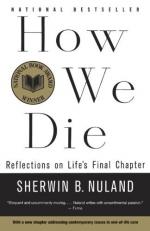
|
| Name: _________________________ | Period: ___________________ |
This test consists of 15 multiple choice questions and 5 short answer questions.
Multiple Choice Questions
1. Who is quoted with the following statement in Chapter 6: “Man is an obligate aerobe”?
(a) Herodotus.
(b) Hippocrates.
(c) Plato.
(d) Aristotle.
2. What refers to the process by which the ability to grow new cells or perform exchanges in muscle, cells, or molecules becomes impossible?
(a) Cellular aging.
(b) Hypertension.
(c) Exsanguination.
(d) Metastasis.
3. What refers to the study of the history of words, their origins, and how their form and meaning have changed over time?
(a) Optometry.
(b) Chemotherapy.
(c) Etymology.
(d) Biology.
4. At what age was Irv Lipsiner when he suffered complete cardiac heart failure, according to the author in Chapter 1?
(a) 49.
(b) 92.
(c) 41.
(d) 58.
5. Horace Giddens is a character in a play written by whom?
(a) Phil Whiting.
(b) Rainer Maria Rilke.
(c) Lillian Hellman.
(d) William Caxton.
6. What was the name of Dr. Nuland’s brother?
(a) Harvey Nuland.
(b) Roger Nuland.
(c) Edmond Nuland.
(d) Robert Nuland.
7. Dr. Nuland was in what year of his medical studies when he encountered James McCarty?
(a) His sixth year.
(b) His seventh year.
(c) His first year.
(d) His third year.
8. What was the profession of James McCarty?
(a) An auto mechanic.
(b) A construction executive.
(c) A plumber.
(d) A real estate agent.
9. According to the author in the Introduction, “Everyone wants to know the details of dying, though few are willing to” what?
(a) “Ask the tough questions.”
(b) “Investigate.”
(c) “Speculate.”
(d) “Say so.”
10. The human embryonic heart begins beating at around how many days after conception?
(a) 7.
(b) 150.
(c) 21.
(d) 90.
11. What does Dr. Nuland discuss that is also called also called coronary artery or coronary heart disease in Chapter 1?
(a) Corollary heart disease.
(b) Alzheimer’s disease.
(c) Ischemic heart disease.
(d) Hodgkinson’s disease.
12. What is the third of the seven most common causes of death for 85% of the elderly population, as discussed in Chapter 4?
(a) Alzheimer’s Disease and dementia.
(b) Decreased resistance to infection.
(c) Transient ischemic attack.
(d) Hypertention.
13. While in the midst of doing his admission paperwork, Dr. Nuland observed James McCarty begin to do what, according to the author in Chapter 1?
(a) Scratch his arms intensely.
(b) Convulse and shout.
(c) Tap his feet rapidly.
(d) Sweat and cry.
14. What refers to neurotransmitters that are produced by the pituitary gland and the hypothalamus in vertebrates during exercise, excitement, pain, consumption of spicy food, love and orgasm?
(a) Endorphins.
(b) Atria.
(c) Metabolomics.
(d) Ventricles.
15. How old was the woman that the author described having operated on for early-stage breast cancer in the Introduction?
(a) 56.
(b) 35.
(c) 43.
(d) 29.
Short Answer Questions
1. Horace Giddens is a character in what play?
2. How old was Katie Mason when she died?
3. How old was James McCarty when he was admitted to the university hospital where Dr. Nuland worked?
4. Who was the first physician to correctly diagnose myocardial infarction?
5. How many of the most common disease categories does the author intend to focus on, according to the Introduction?
|
This section contains 458 words (approx. 2 pages at 300 words per page) |

|




